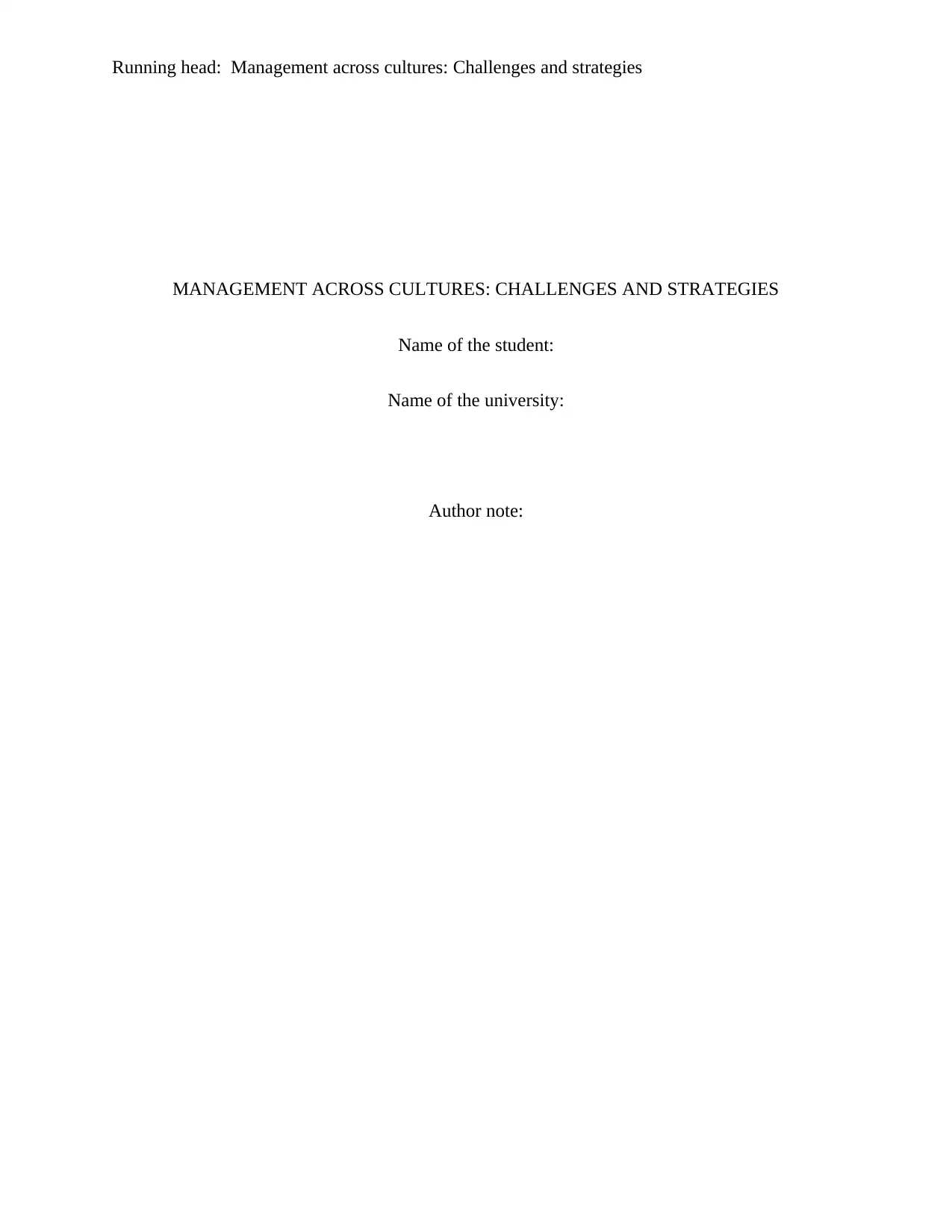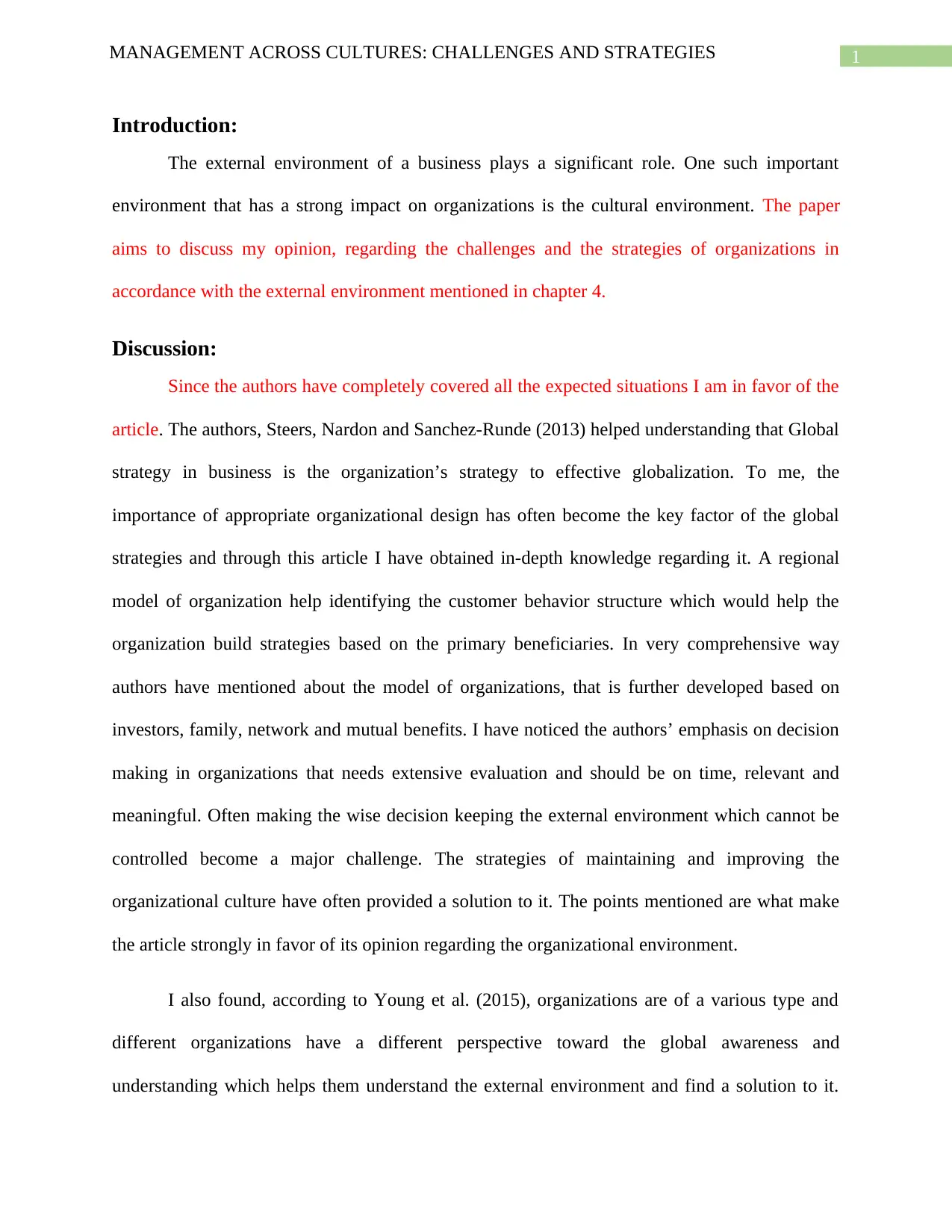Analyzing Management Across Cultures: Challenges and Strategies
VerifiedAdded on 2023/06/05
|4
|568
|149
Essay
AI Summary
This essay explores the challenges and strategies associated with managing across cultures, drawing upon the work of Steers, Nardon, and Sanchez-Runde (2013) who emphasize the importance of global strategy and organizational design. The author supports the article's assertion that a regional m...

Running head: Management across cultures: Challenges and strategies
MANAGEMENT ACROSS CULTURES: CHALLENGES AND STRATEGIES
Name of the student:
Name of the university:
Author note:
MANAGEMENT ACROSS CULTURES: CHALLENGES AND STRATEGIES
Name of the student:
Name of the university:
Author note:
Paraphrase This Document
Need a fresh take? Get an instant paraphrase of this document with our AI Paraphraser

1MANAGEMENT ACROSS CULTURES: CHALLENGES AND STRATEGIES
Introduction:
The external environment of a business plays a significant role. One such important
environment that has a strong impact on organizations is the cultural environment. The paper
aims to discuss my opinion, regarding the challenges and the strategies of organizations in
accordance with the external environment mentioned in chapter 4.
Discussion:
Since the authors have completely covered all the expected situations I am in favor of the
article. The authors, Steers, Nardon and Sanchez-Runde (2013) helped understanding that Global
strategy in business is the organization’s strategy to effective globalization. To me, the
importance of appropriate organizational design has often become the key factor of the global
strategies and through this article I have obtained in-depth knowledge regarding it. A regional
model of organization help identifying the customer behavior structure which would help the
organization build strategies based on the primary beneficiaries. In very comprehensive way
authors have mentioned about the model of organizations, that is further developed based on
investors, family, network and mutual benefits. I have noticed the authors’ emphasis on decision
making in organizations that needs extensive evaluation and should be on time, relevant and
meaningful. Often making the wise decision keeping the external environment which cannot be
controlled become a major challenge. The strategies of maintaining and improving the
organizational culture have often provided a solution to it. The points mentioned are what make
the article strongly in favor of its opinion regarding the organizational environment.
I also found, according to Young et al. (2015), organizations are of a various type and
different organizations have a different perspective toward the global awareness and
understanding which helps them understand the external environment and find a solution to it.
Introduction:
The external environment of a business plays a significant role. One such important
environment that has a strong impact on organizations is the cultural environment. The paper
aims to discuss my opinion, regarding the challenges and the strategies of organizations in
accordance with the external environment mentioned in chapter 4.
Discussion:
Since the authors have completely covered all the expected situations I am in favor of the
article. The authors, Steers, Nardon and Sanchez-Runde (2013) helped understanding that Global
strategy in business is the organization’s strategy to effective globalization. To me, the
importance of appropriate organizational design has often become the key factor of the global
strategies and through this article I have obtained in-depth knowledge regarding it. A regional
model of organization help identifying the customer behavior structure which would help the
organization build strategies based on the primary beneficiaries. In very comprehensive way
authors have mentioned about the model of organizations, that is further developed based on
investors, family, network and mutual benefits. I have noticed the authors’ emphasis on decision
making in organizations that needs extensive evaluation and should be on time, relevant and
meaningful. Often making the wise decision keeping the external environment which cannot be
controlled become a major challenge. The strategies of maintaining and improving the
organizational culture have often provided a solution to it. The points mentioned are what make
the article strongly in favor of its opinion regarding the organizational environment.
I also found, according to Young et al. (2015), organizations are of a various type and
different organizations have a different perspective toward the global awareness and
understanding which helps them understand the external environment and find a solution to it.

2MANAGEMENT ACROSS CULTURES: CHALLENGES AND STRATEGIES
The challenges of an organization are related to global strategy and structure, regional models of
organization, control, participation and decision making and organizational culture may find
different unexpected situations. Although it would be a rare part, circumstances may arise.
Conclusion:
There are adequate reasons for being in favor of the article. The article summons all the
possible issues and provides suitable strategies. However, there can be extremely exceptional
cases or situations for certain organizations which may fail to face the challenges with the
provided strategies. Apart from the exceptional cases the article adequately satisfies the
organizational needs.
The challenges of an organization are related to global strategy and structure, regional models of
organization, control, participation and decision making and organizational culture may find
different unexpected situations. Although it would be a rare part, circumstances may arise.
Conclusion:
There are adequate reasons for being in favor of the article. The article summons all the
possible issues and provides suitable strategies. However, there can be extremely exceptional
cases or situations for certain organizations which may fail to face the challenges with the
provided strategies. Apart from the exceptional cases the article adequately satisfies the
organizational needs.
⊘ This is a preview!⊘
Do you want full access?
Subscribe today to unlock all pages.

Trusted by 1+ million students worldwide

3MANAGEMENT ACROSS CULTURES: CHALLENGES AND STRATEGIES
Reference:
Steers, R.M., Nardon, L. and Sanchez-Runde, C.J., 2013. Management across cultures:
Developing global competencies. (2nd ed.), Cambridge University Press. pp. 107-149
Young, W., Davis, M., McNeill, I.M., Malhotra, B., Russell, S., Unsworth, K. and Clegg, C.W.,
2015. Changing behaviour: successful environmental programmes in the workplace. Business
Strategy and the Environment, 24(8), pp.689-703.
Reference:
Steers, R.M., Nardon, L. and Sanchez-Runde, C.J., 2013. Management across cultures:
Developing global competencies. (2nd ed.), Cambridge University Press. pp. 107-149
Young, W., Davis, M., McNeill, I.M., Malhotra, B., Russell, S., Unsworth, K. and Clegg, C.W.,
2015. Changing behaviour: successful environmental programmes in the workplace. Business
Strategy and the Environment, 24(8), pp.689-703.
1 out of 4
Related Documents
Your All-in-One AI-Powered Toolkit for Academic Success.
+13062052269
info@desklib.com
Available 24*7 on WhatsApp / Email
![[object Object]](/_next/static/media/star-bottom.7253800d.svg)
Unlock your academic potential
© 2024 | Zucol Services PVT LTD | All rights reserved.



